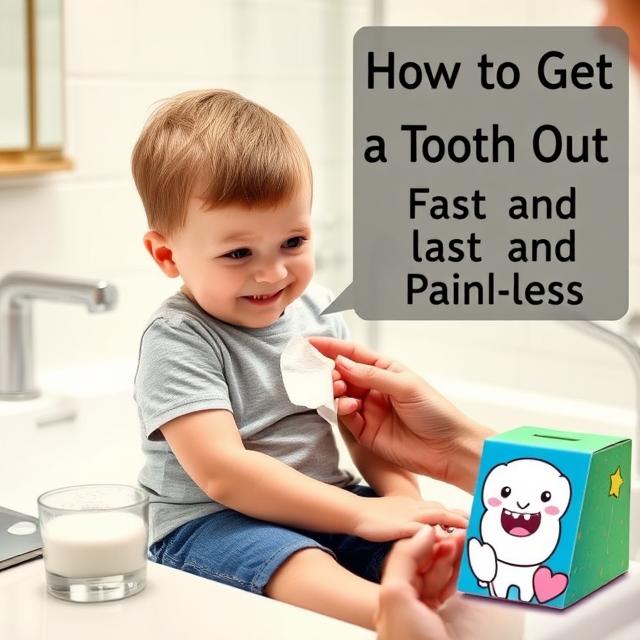How to Get a Tooth Out Fast and Painless Child: Losing baby teeth is a natural part of childhood, but it can be stressful for both kids and parents when a tooth is stubbornly loose. Whether your child is eager for the tooth fairy’s visit or you’re dealing with a wiggly tooth causing discomfort, you’ll want to remove it as safely and painlessly as possible.
This comprehensive guide covers the best techniques for painless tooth removal, what to avoid, and how to make the experience positive for your child.
Table of Contents
Understanding Loose Teeth in Children
Children typically start losing baby teeth between ages 5-7, though some may begin earlier or later. The process continues until about age 12 when most permanent teeth have erupted.
Signs a Tooth Is Ready to Come Out:
- Moves easily when wiggled (not just slightly loose)
- Bleeds minimally when touched
- Child can push it forward/backward with their tongue
- Permanent tooth may already be visible behind it
Never force a tooth that isn’t ready—this can cause pain, damage gums, or lead to infection.
5 Safe Methods to Remove a Loose Tooth Painlessly
1. Let Nature Take Its Course (Best Option)
- Encourage your child to wiggle it with clean fingers or tongue
- Eating crunchy foods (apples, carrots) often helps it fall out naturally
- Advantage: Completely painless, child remains in control
2. The Clean Tissue Method
- Wash hands thoroughly
- Wrap a clean tissue or gauze around the tooth
- Gently twist while applying slight downward pressure
- If it resists, wait another day
3. The “Bite and Pull” Technique
- Have child bite down on a soft, clean object (like a folded washcloth)
- While biting, quickly pull the tooth straight out
- Works well for very loose teeth barely hanging on
4. Cold Spoon Method (For Teeth with Some Resistance)
- Chill a metal spoon in ice water
- Press the back of the spoon against the gum line near the tooth
- The cold helps numb the area while you gently twist the tooth
5. Dental Floss Technique
- Tie clean floss around the tooth
- Give a quick, firm pull (have child distracted when you do this)
- Best for front teeth that are very loose
What NOT to Do When Removing a Child’s Tooth
❌ Don’t use pliers or sharp tools – Risk of injury and infection
❌ Avoid tying string to doorknobs – Can damage surrounding teeth
❌ Don’t ignore excessive bleeding – Should stop within 5-10 minutes
❌ Never force a tooth that isn’t ready – Can damage developing permanent tooth
❌ Avoid numbing creams unless advised by dentist – Can cause allergic reactions
Making the Experience Positive for Your Child
Pain Management Tips:
- Apply a cold washcloth to gums afterward
- Use children’s ibuprofen if needed (follow dosage instructions)
- Offer cold treats like popsicles to reduce swelling
Reducing Anxiety:
- Let them be involved in the process
- Create excitement about the tooth fairy
- Use distraction techniques (counting, favorite video)
When to See a Dentist:
- Tooth is extremely loose but won’t come out after 2+ weeks
- Significant pain or swelling develops
- Permanent tooth is coming in behind baby tooth (shark teeth)
- Excessive bleeding that won’t stop
Aftercare: What to Do Once the Tooth Is Out
- Control bleeding: Have child bite gently on clean gauze for 10 minutes
- Keep area clean: No vigorous rinsing for 24 hours
- Soft foods only: For the first day (avoid straws which can dislodge clot)
- Monitor healing: Pink gums should form within 1-2 days
FAQs: Painless Tooth Removal for Children
1. How loose should a tooth be before pulling it?
It should move easily in all directions with minimal resistance and little/no pain when wiggled.
2. What’s the least scary way to remove a child’s tooth?
Letting them wiggle it out themselves or using the clean tissue method while they’re distracted.
3. How can I numb the area before pulling?
A popsicle or ice cube rubbed on the gums works better than topical numbing agents.
4. My child swallowed their tooth – is this dangerous?
No, it will pass harmlessly. Just inform the tooth fairy!
5. Why won’t my child’s loose tooth come out?
Some teeth take weeks to fully detach. If it’s not ready, waiting prevents trauma.
6. When should I be concerned about a loose tooth?
If it’s been loose for months, causes constant pain, or the gum looks infected.
Conclusion
Removing a child’s loose tooth doesn’t have to be traumatic. With patience, the right technique, and a positive approach, you can make this childhood milestone quick and painless. Remember that natural tooth loss is always best when possible, but when intervention is needed, the gentle methods outlined here will help ensure a smooth experience.
The key is to wait until the tooth is truly ready, keep everything clean, and make your child feel comfortable and in control. Before you know it, they’ll be proudly showing off their new gap-toothed smile and anticipating a visit from the tooth fairy!

